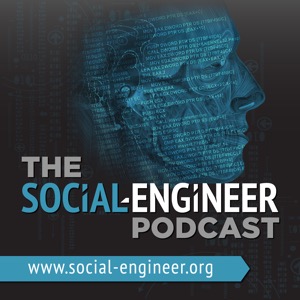Ep. 189 - The Doctor Is In Series - Neurons That Fire Together Wire Together
The Social-Engineer Podcast - A podcast by Social-Engineer, LLC - Mondays

Categories:
Welcome to the Social-Engineer Podcast: The Doctor Is In Series – where we will discuss understandings and developments in the field of psychology. In today’s episode, Chris and Abbie are discussing: Natural born killers, or monsters in the making? We are all curious about the origins of evil and violence. We see a story on the news and ask ourselves, how could anyone do that? So, let’s dive into how. We are not going to cover specific cases and talk about specific serial killers, because you lose the science and we “celebritize” serial killers. [Dec 05, 2022] 00:00 – Intro 00:19 – Dr. Abbie Maroño Intro 00:52 – Intro Links Social-Engineer.com - http://www.social-engineer.com/ Managed Voice Phishing - https://www.social-engineer.com/services/vishing-service/ Managed Email Phishing - https://www.social-engineer.com/services/se-phishing-service/ Adversarial Simulations - https://www.social-engineer.com/services/social-engineering-penetration-test/ Social-Engineer channel on SLACK - https://social-engineering-hq.slack.com/ssb CLUTCH - http://www.pro-rock.com/ innocentlivesfoundation.org - http://www.innocentlivesfoundation.org/ 03:37 – The topic of the day: Natural born killers, or monsters in the making? 04:48 – Born this way? 08:25 – The "X" Factor 10:11 – Self-soothing 13:18 – The importance of Anxiety 14:34 – Made by the military 15:23 – You can't pick and choose 18:18 – Gag reflex 19:50 – Who's to blame? 20:59 – The "Criminal Gene" fallacy 24:39 – A happy ending 26:50 – “This isn't set in stone” 29:31 – Silver Linings 31:13 – “It's a bit of both” 32:02 – Misguided markers 35:42 – Is there prevention? 39:05 – Minority Report 41:18 – An unsupportive system 42:34 – Touch is vital! 45:26 – An interesting (NOT FUN!) quote 46:27 – Wrap Up 47:07 – The request lines are open! 47:35 – Outro www.social-engineer.com www.innocentlivesfoundation.org Find us online: Twitter: https://twitter.com/abbiejmarono LinkedIn: linkedin.com/in/dr-abbie-maroño-phd-35ab2611a Twitter: https://twitter.com/humanhacker LinkedIn: linkedin.com/in/christopherhadnagy References: Entail, W. D. A. S. K. (2021). Are Serial Killers Born or Made?. Johnson, B. R., & Becker, J. V. (1997). Natural born killers?: The development of the sexually sadistic serial killer. Journal of the American Academy of Psychiatry and the Law Online, 25(3), 335-348. Ioana, I. M. (2013). No one is born a serial killer!. Procedia-Social and Behavioral Sciences, 81, 324-328. Mitchell, H., & Aamodt, M. G. (2005). The incidence of child abuse in serial killers. Journal of Police and Criminal Psychology, 20(1), 40-47. Miller, L. (2014). Serial killers: I. Subtypes, patterns, and motives. Aggression and Violent Behavior, 19(1), 1-11. Wiest, J. B. (2016). Casting cultural monsters: Representations of serial killers in US and UK news media. Howard Journal of Communications, 27(4), 327-346. Wrangham, R. W., Wilson, M. L., & Muller, M. N. (2006). Comparative rates of violence in chimpanzees and humans. Primates, 47(1), 14-26. Newton-Fisher, N. E., & Thompson, M. E. (2012). Comparative evolutionary perspectives on violence. Marono, A. J., Reid, S., Yaksic, E., & Keatley, D. A. (2020). A behaviour sequence analysis of serial killers’ lives: From childhood abuse to methods of murder. Psychiatry, psychology and law, 27(1), 126-137. Marono, A., & Keatley, D. A. (2022). An investigation into the association between cannibalism and serial killers. Psychiatry, Psychology and Law, 1-12. Entail, W. D. A. S. K. (2021). Are Serial Killers Born or Made?. Njelesani, J., Hashemi, G., Cameron, C., Cameron, D., Richard, D., & Parnes, P. (2018). From the day they are born: a qualitative study exploring violence against children with disabilities in West Africa. BMC public health, 18(1), 1-7. Boyle, K. (2001). What's natural about killing? Gender, copycat violence and Natural Born Killers. Journal of Gender Studies, 10(3), 311-321. Formosa, P. (2008). The problems with evil. Contemporary Political Theory, 7(4), 395-415.
